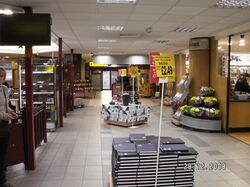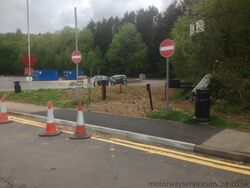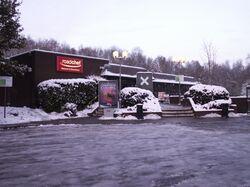History of Rownhams services

The newer eastbound building in 1987.

When the M27 was built, Rownhams services's parking and access roads were built at the same time. The amenity buildings were developed afterwards and the first side opened about a year later.
Tendering
The site of the service area was chosen at Great Copse as it is 12 miles from the original planned service area at Meon Valley. Residents were informed of the plan in August 1970 and were furious. They had previously argued that the motorway should be routed further north but were over-ruled; they felt this wouldn't have happened if the inspector knew a service area was being included too.
When Rownhams opened to bids in 1973, Trusthouse Forte were forbidden from taking part because they already ran the nearest service area at the time, which was Fleet. In an administrative error, Forte were accidentally sent the tendering papers, which they used to argue they should take part.
Forte did get to take part, and were joined by Roadchef and two new firms: Blackburn & Son Ltd and Hanover Ltd. Roadchef were brand new to the game, and made a very ambitious bid.
Rownhams was one of three service areas which trialled only selling two brands of fuel, as the site was deemed "non-critical" when it was planned. Interested developers were also told that there should be a café and a transport café on each side, and that the investment must be at least £350,000 (worth around £3million in 2025). Roadchef also believed that figures showed that by 1976, this would be one of the UK's busiest service areas.
The site was 33 acres in size, spread across two sides with the Department of the Environment providing a subway between the two. The Department's decision to build a subway was to reduce the visual impact, and to take advantage of the hill that the road is built across. Several motorway service area subways were planned in the 1970s.
Westbound Opening
Prior Report, 1978.
Whilst the westbound service area was under construction, temporary buildings were provided here. The opening documents for the site were signed on 21 June 1976.
In the Prior Report of 1978, operating Rownhams was compared to "running an ocean liner while waiting for the tide to come in". The Department of Transport were more blunt, calling it "the white elephant". It stuck out from all the other service areas as a complete white elephant, which was blamed on delays in completing the M3 and M27; the M27 ended just a mile east of here until 1984. Various documents from the time would refer to Rownhams as the exception to every rule, policy and pattern, with one study excluding Rownhams because it had "well-known, special problems".
When the completion of the M3 was postponed indefinitely, Roadchef raised a complaint about all the trade they were losing. In return they were offered a small amount of compensation.
The restaurant was open from 7am until 11pm. Fuel was sold by BP, Esso, Elf and Amoco. In 2013 the forecourts changed from being branded Esso to BP.
Building

The older of the two sides, Rownhams westbound opened a short while after the M27 and consisted of a white building with several hexagonal points, brown tinted windows and bare brick indoors. It had one large restaurant rather than the conventional two or three. It was designed to be relatively well camouflaged, with the whole complex being lower than that of the motorway and the main entrance being unusually discreet for a service station.
The Rownhams 'green dream' was slightly compromised when the original planning inspectorate's idea of a rooftop garden were written off as being too expensive. The building became more visible after the trees along the M27 were removed for roadworks in 2008, and trees by the entrance began to be cut back in 2012.
When the first building opened, eastbound traffic could access the new site through the underpass, which came out at the coach entrance to the service area. With the coach park moving and the need for the subway ending, this entrance became very quiet, although it saw a brief return to popularity when McDonald's was only available westbound.
A plaque inside marks the opening of a "RoadChef development" on 1 July 1985; shortly after the completion of the M27. This was attended by Lord Montagu, and celebrated the opening of a new 250-seat self-service restaurant and "indoor shopping mall". It was criticised by Egon Ronay for being dirty in 1989, with graffiti and cracked tiles in the toilets, "grubby crockery" and "dirty floors". He was also critical of the need to walk through the "seedy" subway at night.
From the outside, the building was largely unchanged from 1977 until 2012. One unfulfilled early 2000s plan would have added a curved aluminium roof to the building.
Branding and Layout

Upon opening, the toilets were at the front (facing the car park, one by each entrance), and the restaurant was at the back, which extended back further than it looks. Within this, a coffee shop was introduced to the middle and then moved closer to the aisle.
The western end of the restaurant was syphoned off to become a Wimpy bar, then The Burger Company. The exact history here isn't clear as proposals had been put forward through the 2000s to add McDonald's, Wimpy, Costa and Dr Beak's Chicken to the fringes of the restaurant, and many of these didn't materialise, but it looks like one former seating area then became a boardroom. In any case, by each entrance an extra shop was introduced - one was called Surf Shack and became a temporary Costa, and the other was replaced in favour of this mysterious supplementary restaurant. During these changes, the usefulness of the atrium room that was within the restaurant was reduced.
A hotel was built here in around 1989. It was initially branded RoadChef Lodge, then Travel Inn, Premier Inn, and is now Days Inn. It was built next to what used to be the coach park, a decision which was justified because the parking areas were seriously under-used.
For some years, a portable building was positioned by the front of the building to provide tourist information. Tourist information has since been removed from most service areas, but similar structures have been used to hold temporary shops here. A children's play area was added to the garden in 1993, and removed in 2011.
Developments
Initially, service areas were expected to help with broken down vehicles. This resulted in a garage facility, which was taken over by the recovery firm Boarhunt to be used as a base. This closed in 2018 and was demolished to create more parking.
In Spring 2012 McDonald's was introduced to the service area, taking the opportunity to reface the front of the building, creating a much more prominent entrance and changing the layout of the interior to create a larger Costa area and smaller restaurant, with the lobby directing customers in to the restaurant area rather than the toilets.
Significant changes were made in 2017. The old rear entrance was blocked off and the toilets were moved here. Costa was moved to a new position underneath the atrium roof, bringing it back into use. A new entrance and foyer were built, directing people to a more spacious central area.
More changes were made in 2019, when Leon and SPAR were introduced. The McDonald's restaurant was turned into a drive-thru in 2022; to fit the lane in, the flow within the car park was reversed and the car park entrance moved. This opened on 23 June, with an official opening ceremony attended by Roadchef CEO Mark Fox and The Services King.
Rear Access Saga

When the service area was planned in 1971, the main objection from residents was that the Rear Access would be used as a shortcut to join the motorway. The Department for the Environment tried to assure them that this would be controlled.
Within weeks of Rownhams opening, complaints were received that drivers were using the rear access. The authorities were slow to act; they wanted to pass the issue to Roadchef, but were reluctant to do so because Roadchef were already unhappy with the costs of running Rownhams.
A year later, gates were installed, but these were frequently left open. In 1978 the Department of Transport admitted that they had no suggestions as to how the road could be controlled. Eventually, in 1979, Hampshire County Council agreed to carry out a traffic survey, but this established that the problem was not as severe as had been expected.
In the 21st century, Hampshire Constabulary continues to receive complaints from residents, though given the road layout in the area it is logical to suggest that the majority of the 'abusers' are local residents. A rising barrier was replaced several times during the 2010s, but usually vandalised within a few weeks.
The road was moved in 2015, to direct traffic away from the car park, making it safer to operate. Both accesses were eventually stopped up completely in 2017.
Eastbound Building

The eastbound building has a more traditional late-'80s brick and glass building. It is actually higher up than its surroundings, but the darker colours mean it still blends in. It's much smaller than the other side, but this is almost a given seeing as it was only built to relieve it.
The opening of the service area was presumably delayed until the completion of the M27 past Hedge End, to make up for the traffic problems which were experienced by the westbound side. Until it was built, all the car park took you to was a pathway through to the other side. This is still there, but rarely used.
As a result of the smaller restaurant area, no fast food service was provided until 2015, although when Roadchef operated The Burger Company, they did make some of their products available. The McDonald's which opened on the westbound side in 2012 encouraged a lot of people to walk through the tunnel, so space was made for an eastbound one in 2015, instead of the main restaurant option.
In 2000 and again in 2006, there were plans to build a lodge in the gap by the car park, but this never happened. The road signs still suggest there is a lodge here, and previously people would have been able to visit the westbound lodge via the rear access, but the markings for this have faded and the official advice is now to turn around at the next junction (which cannot actually be done, but never mind).
Incidents
The eastbound service area was closed for four days in November 2014, after diesel was spilled across the exit slip road.
Early on the morning of 14 November 2017, the refurbished entrance to the westbound service area was severely damaged when two vehicles were deliberately driven in to it, in order to access and steal a cash machine. The amenity building, which had customers in it at the time, was closed for several hours to allow for investigations and an inspection of the structure.
The eastbound service area was the victim of a violent robbery on 15 December 2025, and was closed for an investigation as a result.